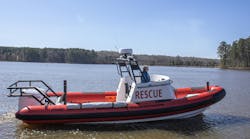December's Firehouse Magazine continued examining how you can successfully implement a thermal imaging training program within your department. The article identifies three key phases to TI training: introductory, recurrent and concurrent. The majority of this three-part series has emphasized the introductory phase. This is logical, as it is the most important step to proper TI use and the most overwhelming phase to develop. You must remember to address the other two phases as well. Online, we will examine some resources available to you for recurrent and concurrent TI training.
Recurrent
You can develop recurrent training components as subsets of the introductory program, have company officers develop their own, or refer to other articles archived on Firehouse.com that specifically provide potential drills. While it takes serious planning at the forefront, your introductory program can be designed in such a manner as to be broken down into smaller bites, each of which could be rehashed at the firehouse during company training. This allows you to plan both phases of training at once, but it demands creativity and focus on your part.
You can also develop a number of weekly or monthly short drills for individual companies to use at specified intervals. By designing just 10 or 12 drills, you can provide a rotation that ensures companies practice each basic drill at least once a year. While this brings variety and is relatively easy, it is still additional work that must be completed and distributed.
Your third resource option is right here at Firehouse.com. A number of my articles in both Firehouse Magazine and on Firehouse.com specifically address methods for company officers to train their firefighters on thermal imaging tips. By no means are these articles the "be-all and end-all" to recurrent training, but they are an easy starting point if you have already over-committed your time and resources. The disadvantage is that some of the drills may not be applicable to your companies, or your company officers may not understand the technology well enough to effectively lead the drills.
Concurrent
Concurrent training is probably the most important ongoing effort. This is where your fire companies demonstrate that they can use the thermal imager as an integral tool, and they do not treat it as a stand-alone product. For the TI to be most effective, it has to be used in conjunction with the firefighter's normal efforts and operations.
A TI, when properly used, makes a firefighter more effective and efficient. Note that I did not say the TI makes someone a better firefighter. Basic firefighter skills, good leadership, experience and instincts do that. A TI merely accents all of this by giving the user more information to help him make better decisions. For this to happen, the TI has to be used in nearly every operation...it has to become second nature.
Concurrent training is best accomplished in two steps. First, establish the expectation that the TI will come off the rig at nearly every call, with the exception of a basic medical run. Once your members understand the expectation, they need to practice to it. That means at every drill involving hose pulls or throwing ladders, the TI should be in someone's hand. During search drills, or even confined space drills, your firefighters should practice at least bringing the TI with them and using it if appropriate. In short, you need to make it a habit for them to bring the TI off the rig. Only if it is habit will it actually occur at an emergency incident.
Conclusion
While the bulk of your efforts will be in developing your introductory TI training program, do not neglect the recurrent and concurrent training that will make your TI program successful. Firefighters require regular updates on tools to maintain effectiveness, and the TI is no different. You must also ensure that they incorporate the TI into their normal operations so that emergency use becomes second nature. If you are successful in coordinating all three stages of TI training, you will help your department become a true leader in proper thermal imaging use.
Related Articles:
Jonathan Bastian is a Thermal Imaging Specialist for Bullard. He is certified as a thermal imaging instructor by the Law Enforcement Thermographers' Association (LETA). He is also the author of the FD Training Network "FireNotes" book, Thermal Imaging for the Fire Service. Bastian served 12 years on the North Park, IL, Fire Department, including the last three as a captain. He has taught classes on thermal imaging, rapid intervention teams and search and rescue operations. He is currently a police officer in Lexington, Kentucky. If you have questions about thermal imaging, please send them to [email protected].





